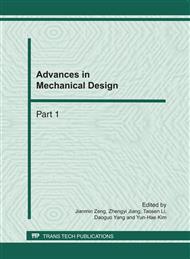p.436
p.445
p.449
p.456
p.463
p.470
p.476
p.481
p.487
Estimation of Fatigue Life for Hydraulic Excavator Boom under All Operating States
Abstract:
Fatigue is one of the most common failure mode in hydraulic excavator boom. To find the most fatigue dangerous operating state of boom and effectively improve the life of the structure, a new method is proposed for the estimation of fatigue life under all operation states. In the case of unknown the history of loading, firstly find out the hinged support force under all boom poses, then calculate the stress of every point of the boom under the actions of each group hinged support force via finite element method, and finally simulate all operating states through the poses combination, conducts analysis of multiaxial fatigue life in the maximum principal stress as the nominal stress, calculates the life and the most dangerous operating state in all points, and compares to obtain the most dangerous position and the life of the boom. The results of contrast analysis showed that: the most dangerous zone of the excavator boom calculated by the life estimation method of all operating states coincide with the actual destruction situation. The life of the structure can be greatly improved after a simple reasonable improvement of the parts.
Info:
Periodical:
Pages:
463-469
Citation:
Online since:
February 2011
Authors:
Price:
Сopyright:
© 2011 Trans Tech Publications Ltd. All Rights Reserved
Share:
Citation:


